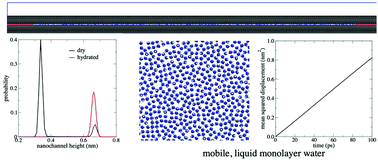A molecular simulation study into the stability of hydrated graphene nanochannels used in nanofluidics devices†
Abstract
Graphene-based nanochannels are a popular choice in emerging nanofluidics applications because of their tunable and nanometer-scale channels. In this work, molecular dynamics (MD) simulations were employed both to (i) assess the stability of dry and hydrated graphene nanochannels and (ii) elucidate the properties of water confined in these channels, using replica-scale models with 0.66–2.38 nm channel heights. The use of flexible nanochannel walls allows the nanochannel height to relax in response to the solvation forces arising from the confined fluid and the forces between the confining surfaces, without the need for application of arbitrarily high external pressures. Dry nanochannels were found to completely collapse if the initial nanochannel height was less than 2 nm, due to attractive van der Waals interactions between the confining graphene surfaces. However, the presence of water was found to prevent total nanochannel collapse, due to repulsive hydration forces opposing the attractive van der Waals force. For nanochannel heights less than ∼1.7 nm, the confining surfaces must be relaxed to obtain accurate hydration pressures and water diffusion coefficients, by ensuring commensurability between the number of confined water layers and the channel height. For very small (∼0.7 nm), hydrated channels a pressure of 231 MPa due to the van der Waals forces was obtained. In the same system, the confined water forms a mobile, liquid monolayer with a diffusion coefficient of 4.0 × 10−5 cm2 s−1, much higher than bulk liquid water. Although this finding conflicts with most classical MD simulations, which predict in-plane order and arrested dynamics, it is supported by experiments and recently published first-principles MD simulations. Classical simulations can therefore be used to predict the properties of water confined in sub-nanometre graphene channels, providing sufficiently realistic molecular models and accurate intermolecular potentials are employed.



 Please wait while we load your content...
Please wait while we load your content...